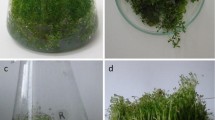Summary
Catechin, a condensed tannin was utilized as sole carbon source by Bradyrhizobium japonicum. Protocatechuic acid, phloroglucinolcarboxylic acid, phloroglucinol, resorcinol and hydroxyquinol were identified as intermediates of catechin degradation. The aromatic substrates favoured good growth up to 5 or 10 mm. B. japonicum tolerated up to 50 mm catechin and phloroglucinolcarboxylic acid, 40 mm phloroglucinol and resorcinol, 30mm protocatechuic acid and 10 mm hydroxyquinol. Catechin-induced cells oxidized catechin more rapidly than uninduced cells. The two final ring compounds of the catechin catabolic pathway, protocatechuic acid and hydroxyquinol, were oxidized differentially. The enzymes of the catechin degradative pathway were inducible in B. japonicum.
Similar content being viewed by others
References
Arunakumari A, Mahadevan A (1984) Utilization of aromatic substances by Pseudomonas solanacearum. Indian J Exp Biol 22:32–36
Bernheim F (1956) Formation in a mycobacterium of an adaptive enzyme for oxidation of phloroglucinol. Proc Soc Exp Biol Med 92:150–151
Chapman PJ, Ribbons DW (1976) Metabolism of resorcinylic compounds by bacteria: alternative pathways for resorcinol catabolism in Pseudomonas putida. J Bacteriol 125:985–998
Chen YP, Glenn AR, Dilworth MJ (1984) Uptake and oxidation of aromatic substrates by Rhizobium leguminosarum MNF 3841 and Rhizobium trifolii TA1. FEMS Microbiol Lett 21:201–205
Glenn AR, Dilworth MJ (1981) Oxidation of substrates by isolated bacteroids and free living cells of Rhizobium leguminosarum 3841. J Gen Microbiol 126:243–247
Groseclose EE, Ribbons DW (1981) Metabolism of resorcinylic compounds by bacteria. New pathway for resorcinol catabolism in Azotobacter vinelandii. J Bacteriol 146:460–466
Hamdi YA, Tewfik MS (1970) Degradation of 3,5-dinitro-o-cresol by Rhizobium and Azotobacter spp. Soil Biol Biochem 2:163–166
Hussien YA, Tewfik MS, Hamdi YA (1974) Degradation of certain aromatic compounds by rhizobia. Soil Biol Biochem 6:377–381
Krumholz LR, Bryant MP (1986) Eubacterium oxidoreducens sp. nov. requiring H2 or formate to degrade gallate, pyrogallol, phloroglucinol and quercitin. Arch Microbiol 144:8–14
Lewis JA, Starkey RL (1969) Decomposition of plant tannins by soil microorganisms. Soil Sci 107:235–241
Lowry OH, Rosebrough NJ, Farr AL, Randall RJ (1951) Protein measurement with the Folin phenol reagent. J Biol Chem 193:265–275
Mahadevan A, Sivaswamy SN (1985) Tannins and microorganisms. In: Mukerje KG, Pathak NC, Singh VP (eds) Frontiers in applied microbiology, vol I. Print House, Lucknow, India, pp 327–347
Muthukumar G, Arunakumari A, Mahadevan A (1982) Degradation of aromatic compounds by Rhizobium spp. Plant Soil 69:163–169
Parke D, Ornston LN (1984) Nutritional diversity of Rhizobiaceae revealed by auxanography. J Gen Microbiol 130:1743–1750
Parke D, Rivelli M, Ornston LN (1985) Chemotaxis to aromatic and hydroaromatic acids: comparison of Bradyrhizobium japonicum and Rhizobium trifolii. J Bacteriol 163:417–422
Parker CA, Trinick MJ, Chatel DL (1977) Rhizobia as soil and rhizosphere inhabitants. In: Hardy RWF, Gibson AH (eds) A treatise on dinitrogen fixation, vol IV. Agriconomy and ecology. Wiley, New York, pp 311–352
Schink B, Pfennig N (1982) Fermentation of trihydroxybenzenes by Pelobacter acidigallici gen. nov. sp. nov., a new strictly anaerobic non-spore forming bacterium. Arch Microbiol 133:195–201
Szewzyk R, Pfennig N (1987) Complete oxidation of catechol by the strictly anaerobic sulfate-reducing Desulfobacterium catecholicum sp. nov. Arch Microbiol 147:163–168
Tsai CG, Jones GH (1975) Isolation and identification of bacteria capable of anaerobic phloroglucinol degradation. Can J Microbiol 21:794–801
Tschech A, Schink B (1985) Fermentative degradation of resorcinol and resorcylic acids. Arch Microbiol 143:52–59
Waheeta A, William F, Mahadevan A (1984) Degradation of catechin by Rhizobium japonicum. Abs. No. 144, 25th Annual Meeting, Association of Microbiologists of India, Dec. 7–9, Pantnagar, India, p. 60
Whittle PJ, Lunt DO, Evans WC (1976) Anaerobic photometabolism of aromatic compounds by Rhodopseudomonas sp. J Biochem Soc Trans 4:490–491
Author information
Authors and Affiliations
Additional information
Offprint requests to: W. Hopper
Rights and permissions
About this article
Cite this article
Hopper, W., Mahadevan, A. Utilization of catechin and its metabolites by Bradyrhizobium japonicum . Appl Microbiol Biotechnol 35, 411–415 (1991). https://doi.org/10.1007/BF00172735
Received:
Accepted:
Published:
Issue Date:
DOI: https://doi.org/10.1007/BF00172735




